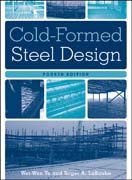
The definitive text in the field, thoroughly updated and expanded Hailed by professionals around the world as the definitive text on the subject, Cold-Formed Steel Design is an indispensable resource for all who design for and work with cold-formed steel. No other book provides such exhaustive coverage of boththe theory and practice of cold-formed steel construction. Updated and expanded to reflect all the important developments that have occurred in the field over the past decade, this Third Edition of the classic text provides you with more of the detailed, up-to-the-minute technical information and expert guidance you need to make optimum use of this incredibly versatile material for building construction. Wei-Wen Yu, an internationally respected authority in the field, draws upon decades of experience in cold-formed steel design, research, teaching, and development of design specifications to provide guidance on all practical aspects of cold-formed steel design for manufacturing, civil engineering, and building applications. Throughout the book, he describes the structural behavior of cold-formed steel members and connections from both the theoretical and experimental perspectives, and discusses the rationale behind the AISI design provisions. Cold-Formed Steel Design, Third Edition features complete coverage of: AISI 1996 cold-formed steel design specification with the 1999 supplement Both ASD and LRFD methods The latest design procedures for structural members Updated design information for connections and systems Contemporarydesign criteria around the world The latest computer-aided design techniques Cold-Formed Steel Design, Third Edition is a necessary tool-of-the-trade for structural engineers, manufacturers, construction managers, and architects. It is also an excellent advanced text for college students and researchers in structural engineering, architectural engineering, construction engineering, and related disciplines INDICE: Preface. 1. Introduction. 1.1 General Remarks. 1.2 Types of Cold-Formed Steel Sections and Their Applications. 1.3 Standardized Metal Buildings and Industrialized Housing. 1.4 Methods of Forming. 1.5 Research and Design Specifications. 1.6 General Design Considerations of Cold-Formed Steel Construction. 1.7 Economic Design and Optimum Properties. 2. Materials Used in Cold-Formed Steel Construction. 2.1 General Remarks. 2.2 Yield Stress, Tensile Strength, and Stress-Strain Curve. 2.3 Modulus of Elasticity, Tangent Modulus, and Shear Modulus. 2.4 Ductility. 2.5 Weldability. 2.6 Fatigue Strength and Toughness. 2.7 Influence of Cold Work on Mechanical Properties of Steel. 2.8 Utilization of Cold Work of Forming. 2.9 Effect of Temperature on Mechanical Propertiesof Steel. 2.10 Testing of Full Sections and Flat Elements. 2.11 Residual Stresses Due to Cold Forming. 2.12 Effect of Strain Rate on Mechanical Properties.3. Strength of Thin Elements and Design Criteria. 3.1 General Remarks. 3.2 Definitions of General Terms. 3.3 Design Basis. 3.4 Serviceability. 3.5 Structural Behavior of Compression Elements and Design Criteria. 3.6 Perforated Elements and Members. 3.7 Plate Buckling of Structural Shapes. 3.8 Additional Information. 4. Flexural Members. 4.1 General Remarks. 4.2 Bending Strength and Deflection. 4.3 Design of Beam Webs. 4.4 Bracing Requirements of Beams. 4.5 Torsional Analysis of Beams and Combined Bending and Torsional Loading. 4.6 Additional Information on Beams. 5. Compression Members. 5.1 General Remarks. 5.2 Yielding. 5.3 Flexural Column Buckling. 5.4 Torsional Buckling and Flexural-Torsional Buckling. 5.5 Effect of Local Buckling on Column Strength. 5.6 Distortional Buckling Strength of Compression Members. 5.7 Effect of Cold Work on Column Buckling. 5.8 North American Design Formulas for Concentrically Loaded Compression Members. 5.9 Effective Length Factor K. 5.10 Built-Up Compression Members. 5.11 Bracing of Axially Loaded Compression Members. 5.12 Design Examples. 5.13 Compression Members Having One Flange Fastened to Decks or Panels. 5.14 Wall Studs. 5.15 Additional Information on Compression Members. 6. Combined AxialLoad and Bending. 6.1 General Remarks. 6.2 Combined Tensile Axial Load and Bending. 6.3 Combined Compressive Axial Load and Bending (Beam-Columns). 6.4 North American Design Criteria. 6.5 Design Examples. 6.6 Second-Order Analysis. 6.7 Additional Information on Beam-Columns. 7. Closed Cylindrical Tubular Members. 7.1 General Remarks. 7.2 Types of Closed Cylindrical Tubes. 7.3 Flexural Column Buckling. 7.4 Local Buckling. 7.5 North American Design Criteria. 7.6 Design Examples. 8. Connections. 8.1 General Remarks. 8.2 Types of Connectors. 8.3 Welded Connections. 8.4 Bolted Connections. 8.5 Screw Connections. 8.6 Other Fasteners. 8.7 Rupture Failure of Connections. 8.8 I- or Box-Shaped Compression Members Made by Connecting Two C-Sections. 8.9 I-Beams Made by Connecting Two C-Sections. 8.10 Spacing of Connections in Compression Elements. 9. Steel Shear Diaphragms and Shell Roof Structures. 9.1 General Remarks. 9.2 Steel Shear Diaphragms. 9.3 Structural Members Braced by Diaphragms. 9.4 Shell Roof Structures. 9.5 Metal Roof Systems. 10. Corrugated Sheets. 10.1 General Remarks. 10.2 Applications. 10.3 Sectional Properties and Design of Arc-and- Tangent-Type Corrugated Sheets. 10.4 Sectional Properties and Design of Trapezoidal-TypeCorrugated Sheets. 11. Composite Design. 11.1 General Remarks. 11.2 Steel-Deck-Reinforced Composite Slabs. 11.3 Composite Beams or Girders with Cold-FormedSteel Deck. 12. Introduction to Stainless Steel Design. 12.1 General Remarks.12.2 Differences between the Specifications for Carbon Steels and Stainless Steels. 13. Light-Frame Construction. 13.1 General Remarks. 13.2 Framing Standards. 13.3 Design Guides. 14. Computer-Aided Design. 14.1 General Remarks. 14.2Computer Programs for the Design of Cold-Formed Steel Structures. 15. Direct Strength Method. 15.1 General Remarks. 15.2 North American DSM Provisions. 15.3 Commentary on Appendix 1 (DSM). 15.4 Direct Strength Method Design Guide. 15.5 Design Examples. Appendix A. Thickness of Base Metal. Appendix B. Torsion. Appendix C. Formulas for Computing Cross-Sectional Property by. Appendix D. Definitions of Terms. Nomenclature. Acronyms and Abbreviations. Conversion Table. References. Index.
- ISBN: 978-0-470-46245-4
- Editorial: John Wiley & Sons
- Encuadernacion: Cartoné
- Páginas: 512
- Fecha Publicación: 13/10/2010
- Nº Volúmenes: 1
- Idioma: Inglés
